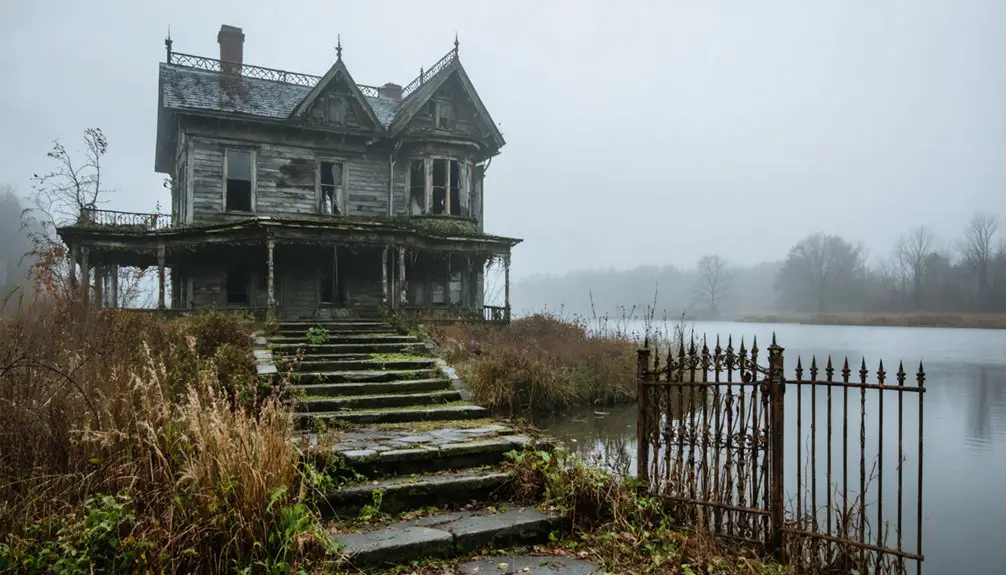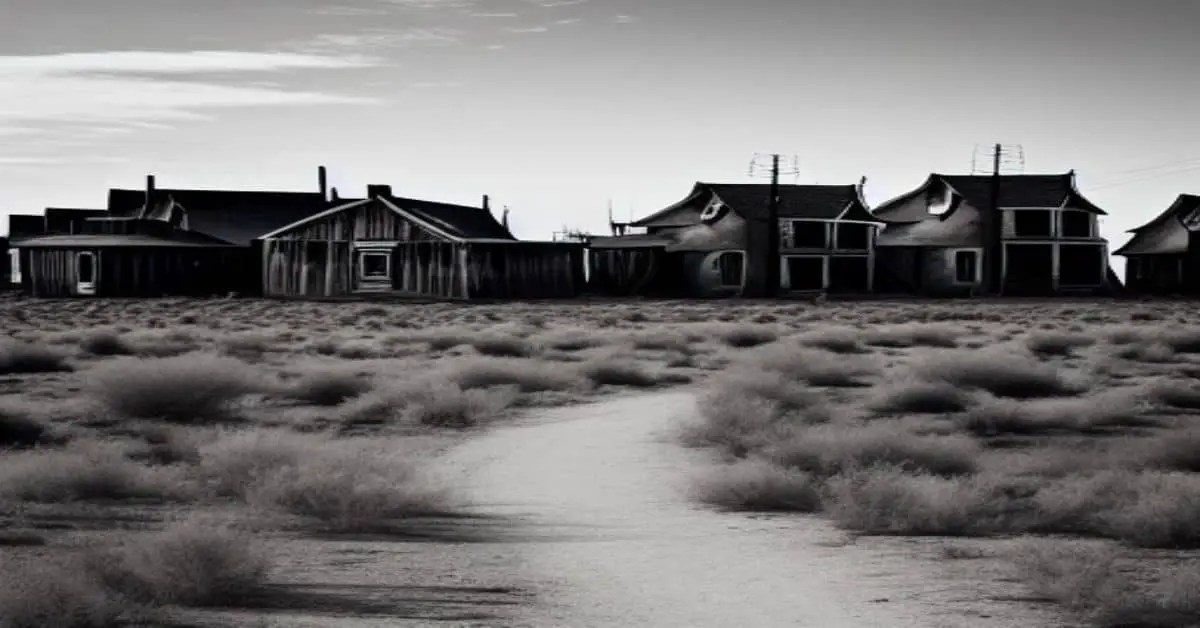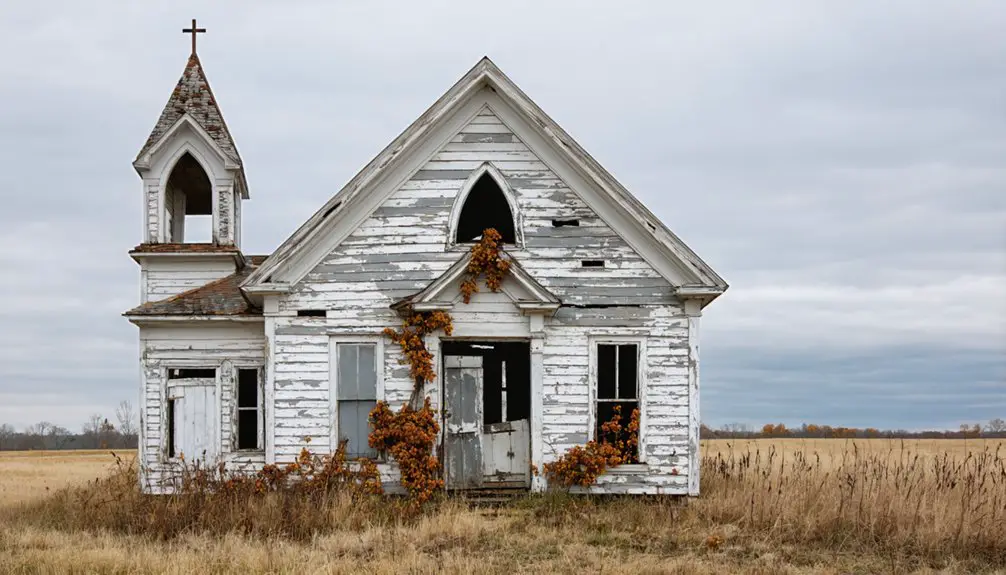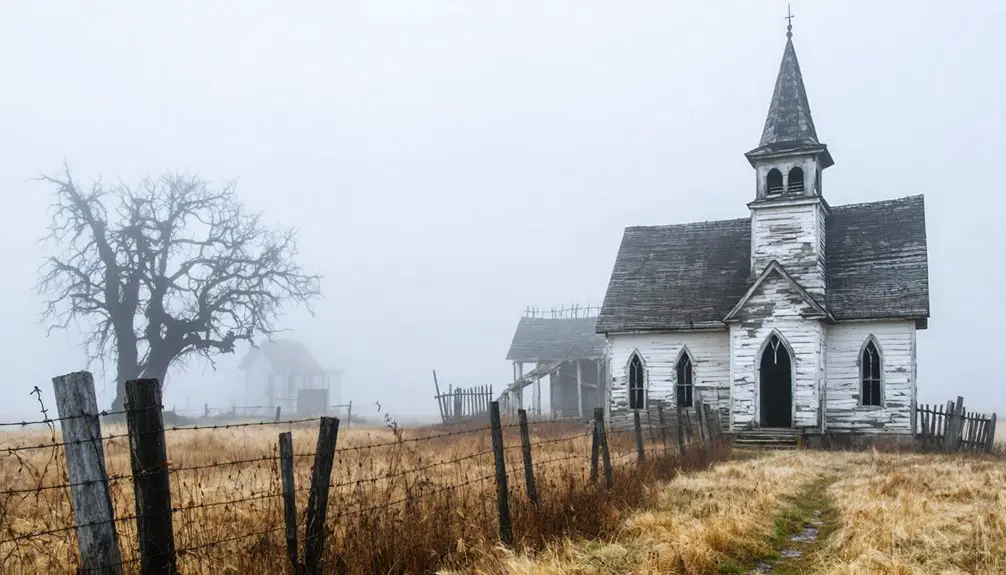You’ll find the haunting remains of Lakeside Estate along Missouri’s Osage River, where an ambitious 1925 resort development once promised year-round luxury living across 377 acres. The grand opening drew 3,000 visitors to enjoy vaudeville shows, a summer theater, and a Figure 8 roller coaster near Lake Taneycomo. Today, only concrete foundations and deteriorating structures hint at its former glory, while untold stories of this ghost town’s dramatic transformation await curious explorers.
Key Takeaways
- Established in 1925, Lakeside Estate was a planned resort community on 377 acres featuring a hotel, golf course, and entertainment venues.
- The resort featured grand attractions including a summer theater, vaudeville shows, fireworks displays, and a Figure 8 roller coaster.
- After Robert Snyder’s death, the resort’s development halted with unfinished utilities, gravel roads, and incomplete infrastructure.
- The property now stands abandoned with deteriorating structures, concrete foundations, and hollow building shells across 900 acres.
- Social media has increased interest in Lakeside Estate as a ghost town exploration site, with no permanent residents remaining.
The Rise of a Missouri Resort Haven
As the Roaring Twenties ushered in an era of economic prosperity, ambitious investors set their sights on Missouri’s scenic Shadow Rock bluff, purchasing 377 acres in 1925 to establish the Shepherd of the Hills Estates.
You’ll find that this resort development wasn’t just another seasonal getaway – it was designed for year-round living with modern utilities and 1,500 planned cottages.
The grand vision included a 75-100 room hotel and a nine-hole golf course. Community planning centered on strategic placement near Lake Taneycomo and Swan Creek, maximizing scenic views and recreational opportunities. This approach to lakeside development would later inspire communities like Innsbrook, which now features over 100 lakes for residents to enjoy. The region’s transformation mirrored the massive changes seen at Lake of the Ozarks, where entire towns were relocated to make way for new developments.
Construction kicked off in 1926, with Shadowrock Drive serving as the main thoroughfare.
When the development hosted its grand opening barbecue that April, you’d have joined 3,000 other visitors from Missouri and Kansas, with Pathe News capturing the excitement.
Life Along the Osage River
While the Osage River carries its name from the powerful Osage Nation, you’ll find their influence extends far beyond the waterway’s designation.
Before European settlers arrived, you’d have witnessed the Osage lifestyle flourishing along these fertile river bends, with their impressive settlements stretching from the Mississippi to the Rockies.
You can trace their strategic movements through the region’s challenging river navigation, where tight meanders and shifting sandbars tested even the most skilled travelers.
After the Louisiana Purchase of 1803, the United States aggressively pursued ownership of these territories, forever changing the landscape of Osage dominion.
The Osage mastered these waters, establishing a sophisticated society built on seasonal buffalo hunts and intricate clan systems.
Mastering river and prairie alike, the Osage people forged a complex civilization centered on seasonal hunting and ancestral ties.
The towering stature of the Osage people made them a distinctive presence in the region, with many men reaching heights over six feet tall.
Today, you’ll still discover their artifacts along the riverbanks, silent reminders of a people whose cultural heritage remains deeply intertwined with these waters, even as German settlers and others later claimed these ancestral lands.
Attractions and Recreational Activities
During its heyday, Lakeside Estate offered visitors a vibrant array of entertainment options centered around its grand summer theater and multipurpose pavilion.
You’d find yourself among 2,000 fellow spectators enjoying vaudeville shows and motion pictures, or gliding across the pavilion floor during roller skating sessions. The venue regularly featured performances by regional talents like ragtime musician James Scott, along with bands and barbershop quartets. The carnival games area provided additional entertainment options for visitors of all ages. Much like Shoal Creek Museum, the estate offered historical reenactments to bring the past to life.
You could enhance your recreational history experience with Sunday night fireworks, thrilling balloon races, and rides on the “double Figure 8” roller coaster.
The estate’s visitor experiences included peaceful stays at Lakeside Inn, dining at the café, and evening strolls along gravel paths illuminated by incandescent lights. A modern bathhouse and mother’s rest room guaranteed your comfort throughout your stay.
Architecture and Infrastructure
You’ll find a striking mix of European castle-inspired mansions and modern resort aesthetics throughout the 900-acre property, though many structures now stand in various states of decay with only their concrete foundations remaining.
The estate’s infrastructure remains particularly incomplete, with gravel roads forming an unfinished arc and utility systems showing little evidence of ever being fully operational. The area gained widespread attention after going viral on TikTok platform. The castle’s original grandeur was cut short when Robert Snyder died in one of Missouri’s first car accidents before construction was completed.
While some architectural elements have proven surprisingly resilient, such as certain intact roofs despite years of exposure, the majority of buildings exhibit significant deterioration from weather damage and vandalism.
Building Styles and Materials
The architectural landscape of Lakeside Estate Ghost Town showcases an ambitious fusion of European castle aesthetics and American resort villa designs, marked by exaggerated Gothic Revival elements.
The architectural influences blend castle-inspired motifs with traditional resort styling, evident in the towering archways and high dormers that once defined these grand structures. Like many boom-and-bust cycles, the town’s elaborate architecture reflected a brief period of prosperity before its eventual abandonment.
You’ll find these distinctive features throughout the remaining structures:
- Concrete foundations and partial walls, now weathered but still standing
- Stone masonry work executed by European-trained craftsmen
- Ornate wooden framing on upper stories with complex roof structures
- Painted stucco exteriors designed to mimic medieval castle walls
The material durability varies considerably, with concrete elements showing remarkable resilience while wooden components have largely succumbed to a decade of exposure and neglect.
Utilities and Road Networks
While grand architectural designs marked Lakeside Estate’s ambitious vision, its infrastructure tells a story of unrealized potential.
You’ll find no functioning utilities across the 900-acre property – the water, sewer, and electrical systems were never completed when bankruptcy struck. The buildings stand as hollow shells without modern utility hookups, a stark reminder of the development’s premature end.
Road accessibility remains limited to rough gravel paths that curve through the valley. When development started, Jim Shirado’s company initiated basic infrastructure work for the first phase.
These unpaved routes, originally meant to connect residential lots and resort amenities, have deteriorated over 12 years of neglect. Nature’s reclamation is evident as vegetation encroaches on these makeshift roads.
The utility challenges mirror those of other failed Missouri resort communities, where infrastructure plans outpaced actual development, leaving behind only partial foundations and deteriorating access ways.
The Community’s Gradual Decline
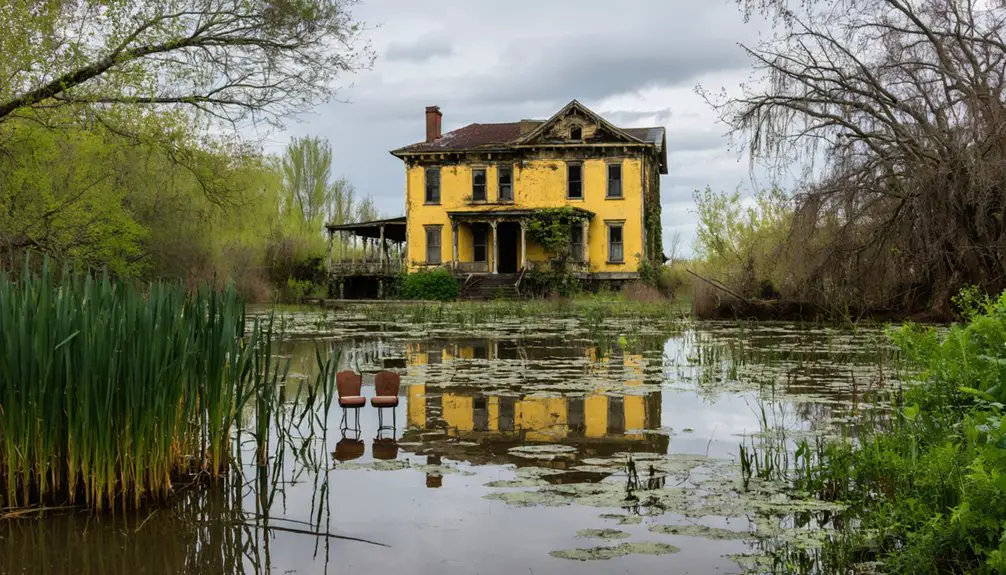
Once a thriving resort destination along Missouri’s Osage River, Lakeside Estate’s decline emerged from multiple converging factors in the early 20th century.
The economic decline accelerated as tourism patterns shifted and competition from newer destinations eroded visitor numbers. Population shifts saw younger residents departing for urban opportunities, leaving an aging community struggling to maintain its liveliness.
You’ll find these stark changes reflected in:
- Abandoned storefronts where tourism-dependent businesses once flourished
- Deteriorating resort infrastructure that never received essential reinvestment
- Former residential properties converted to seasonal-only use
- Empty roads that once buzzed with river-based transport activity
The absence of railroad connections and major highways further isolated the community, while the lack of industrial diversification left no economic alternative to tourism’s decline.
Present-Day Ghost Town Status
Standing in stark abandonment today, Lakeside Estate exemplifies Missouri’s most dramatic resort-to-ghost-town transformations across its 900 wooded acres.
You’ll find concrete foundations and debris fields scattered throughout the property, while a few surprisingly intact structures still retain their roofs despite years of exposure to the elements.
The site’s growing popularity for ghost town exploration stems from recent viral social media exposure, particularly on TikTok.
You can access the ruins via steep, well-worn paths that lead into the valley, though you’ll navigate primarily on gravel roads rather than paved surfaces.
Nature has steadily reclaimed much of the property, creating an atmospheric setting for urban decay enthusiasts.
While visitors occasionally explore the grounds, no permanent residents remain in this officially recognized Benton County ghost town.
Historical Legacy and Preservation
When you visit Lakeside Estate today, you’ll find the quiet remnants of Missouri’s river resort culture, where families once flocked to cabins and lodges along the Osage River for swimming, boating, and leisure activities.
While minimal physical structures remain from this once-thriving vacation destination, the site’s GNIS designation helps preserve its place in Benton County’s recreational heritage.
Local preservation efforts could still capture important oral histories and photographs from descendants of visitors and residents who experienced Lakeside Estate during its heyday as a waterfront retreat.
Remnants of Resort Life
As nature slowly reclaims the 900-acre Lakeside Estate property, the abandoned resort‘s physical remnants tell a story of unrealized ambition in rural Missouri.
You’ll find the skeletal remains of luxury aspirations scattered throughout the heavily wooded landscape, where abandoned dreams stand frozen in time along unpaved gravel roads.
The architectural features that survive paint a picture of the resort’s intended grandeur:
- Masonry foundations and concrete bases emerge from the undergrowth
- High archways and dormers still crown the surviving structures
- Distinctive patterned camouflage adorns exterior walls
- Multiple mansions with partially intact roofs defy a decade of exposure
Despite the development’s financial collapse, these enduring structures serve as silent witnesses to a bold vision of rural recreation that never fully materialized.
River Tourism Heritage
The Missouri River’s rich heritage extends far beyond abandoned resorts like Lakeside Estate, anchoring a thriving tourism economy that generates over $386 million annually.
You’ll discover layers of river heritage spanning thousands of years, from ancient Woodland cultures to the region’s earliest European settlements.
As you explore the river corridor, you’ll encounter sacred sites of the Omaha, Ponca, Yankton Nakota, and Teton Lakota peoples, alongside landmarks from fur trading and exploration eras.
This cultural significance draws visitors who spend substantially on lodging, dining, and experiences, supporting over 250,000 jobs in gateway communities.
The river’s historical treasures, protected through preservation efforts and listed on the National Register of Historic Places, continue attracting heritage tourists who seek authentic connections to America’s past.
Documenting Local Stories
Local stories about Lakeside Estate’s history face unique preservation challenges, requiring careful documentation through oral histories, archival research, and photographic records.
You’ll find that community narratives play an essential role in keeping the town’s memory alive, especially when written documentation is scarce.
To capture Lakeside Estate’s heritage, preservationists focus on:
- Recording interviews with former residents and their descendants
- Collecting and digitizing surviving photographs of buildings and landscapes
- Mapping the settlement using GIS technology and historical land records
- Creating digital archives that combine oral histories with documented facts
While you won’t find extensive written records about Lakeside Estate compared to other Missouri ghost towns, these preservation methods help guarantee its stories aren’t lost to time.
Frequently Asked Questions
Are There Any Remaining Original Structures Still Standing at Lakeside Estate?
You’ll find several original buildings still standing with intact roofs and distinctive architectural features, though they’re weathered. Some structures maintain their oversized arches and high dormers despite years of abandonment.
What Caused the Initial Population Surge Before Its Decline?
In the early 2000s, a 40% regional real estate surge drew you to an area where developers’ promises of lakefront luxury living and economic boom opportunities sparked rapid settlement, though plans ultimately fell short.
Were Any Famous Personalities Known to Vacation at Lakeside Estate?
You won’t find records of celebrity visits or historical figures at this destination, as the resort’s incomplete development and brief operational period didn’t allow time to attract any notable vacationers.
Did Any Significant Historical Events Occur in Lakeside Estate?
You won’t find major historical events tied to Lakeside Estate’s past. While local legends might exist, historical significance remains limited to its role as a recreational resort community by the Osage River.
What Are the Property Ownership and Access Rules Today?
You’ll need to respect private property rights since parcels are individually owned. Access regulations prohibit unauthorized entry, and you could face trespassing charges without proper permissions from current landowners.
References
- https://kids.kiddle.co/Lakeside_Estate
- https://en.wikipedia.org/wiki/Lakeside_Estate
- https://www.geotab.com/ghost-towns/
- https://en.wikipedia.org/wiki/List_of_ghost_towns_in_Missouri
- https://www.kcur.org/arts-life/2022-04-09/ghost-towns-are-all-around-kansas-city-if-you-know-where-to-look
- https://mostateparks.com/sites/mostateparks/files/Branson PI Report.pdf
- https://innsbrook-resort.com/connect/our-history/
- https://www.kcur.org/history/2023-07-27/how-missouri-made-the-lake-of-the-ozarks-crimes-sunken-homes-and-dreams-of-a-midwest-oasis
- https://mostateparks.com/sites/mostateparks/files/Historic Taneycomo Lakefront Tourism Resources of Branson
- https://findingourwayhome.blog/2019/04/15/osage-river-bend/
